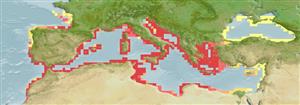Common names from other countries
>
Eupercaria/misc (Various families in series Eupercaria) >
Labridae (Wrasses)
Etymology: Symphodus: Greek, syn, symphysis = grown together + Greek, odous = teeth (Ref. 45335).
More on author: Linnaeus.
Environment: milieu / climate zone / depth range / distribution range
Ecologia
marinhas; estuarina associadas(os) a recifes; intervalo de profundidade 1 - 50 m (Ref. 121253). Subtropical; 47°N - 21°N, 11°W - 42°E
Eastern Atlantic: Spain to Morocco including the Mediterranean and Black Sea.
Length at first maturity / Tamanho / Peso / Idade
Maturity: Lm 11.7, range 12 - 15.2 cm
Max length : 44.0 cm SL macho/indeterminado; (Ref. 3397); common length : 25.0 cm SL macho/indeterminado; (Ref. 3397); Idade máx. registada: 15 anos (Ref. 4742)
Descrição breve
Chaves de identificação | Morfologia | Morfometria
Espinhos dorsais (total) : 15; Raios dorsais moles (total) : 11; Espinhos anais: 3; Raios anais moles: 12.
Adults are found near rocks mainly in eel-grass beds, sometimes in salty lagoons. Often gregarious. Oviparous (Ref. 205). Nest of seaweed built and kept by male with one or more females spawning. Feed on sea urchins, ophiuroids, bivalves, shrimps and crabs (Ref. 4742). Rate of growth is slow (Ref. 4742). Undergoes sex reversal (Ref. 4742).
Oviparous (Ref. 205). One male makes a nest of seaweed for one or more females to spawn in (Ref. 4742). Undergoes sex reversal (Ref. 4742).
Quignard, J.-P. and A. Pras, 1986. Labridae. p. 919-942. In P.J.P. Whitehead, M.-L. Bauchot, J.-C. Hureau, J. Nielsen and E. Tortonese (eds.) Fishes of the north-eastern Atlantic and the Mediterranean. UNESCO, Paris. Vol. 2. (Ref. 4742)
Categoria na Lista Vermelha da IUCN (Ref. 130435)
CITES (Ref. 128078)
Not Evaluated
Ameaça para o homem
Harmless
Utilização humana
Pescarias: pescarias de subsistência; peixe desportivo: sim; Aquário: Espécies comerciais
Ferramentas
Relatórios especiais
Descarregue XML
Fontes da internet
Estimates based on models
Preferred temperature (Ref.
115969): 16.3 - 21.4, mean 18.9 (based on 116 cells).
Phylogenetic diversity index (Ref.
82804): PD
50 = 0.5005 [Uniqueness, from 0.5 = low to 2.0 = high].
Bayesian length-weight: a=0.00933 (0.00783 - 0.01112), b=3.04 (3.00 - 3.08), in cm Total Length, based on LWR estimates for this species (Ref.
93245).
Nível Trófico (Ref.
69278): 3.3 ±0.3 se; based on diet studies.
Resiliência (Ref.
120179): Médio, tempo mínimo de duplicação da população 1,4 - 4,4 anos (K=0.25-0.89(?); tm=2-3; tmax=15).
Fishing Vulnerability (Ref.
59153): Moderate vulnerability (40 of 100).
